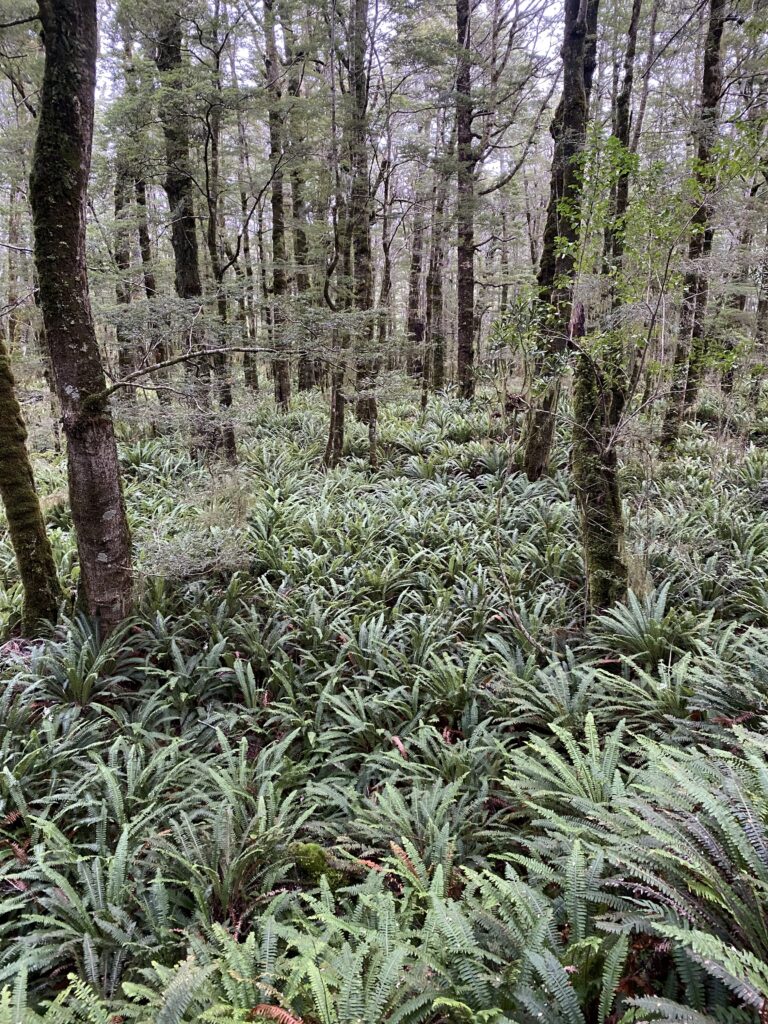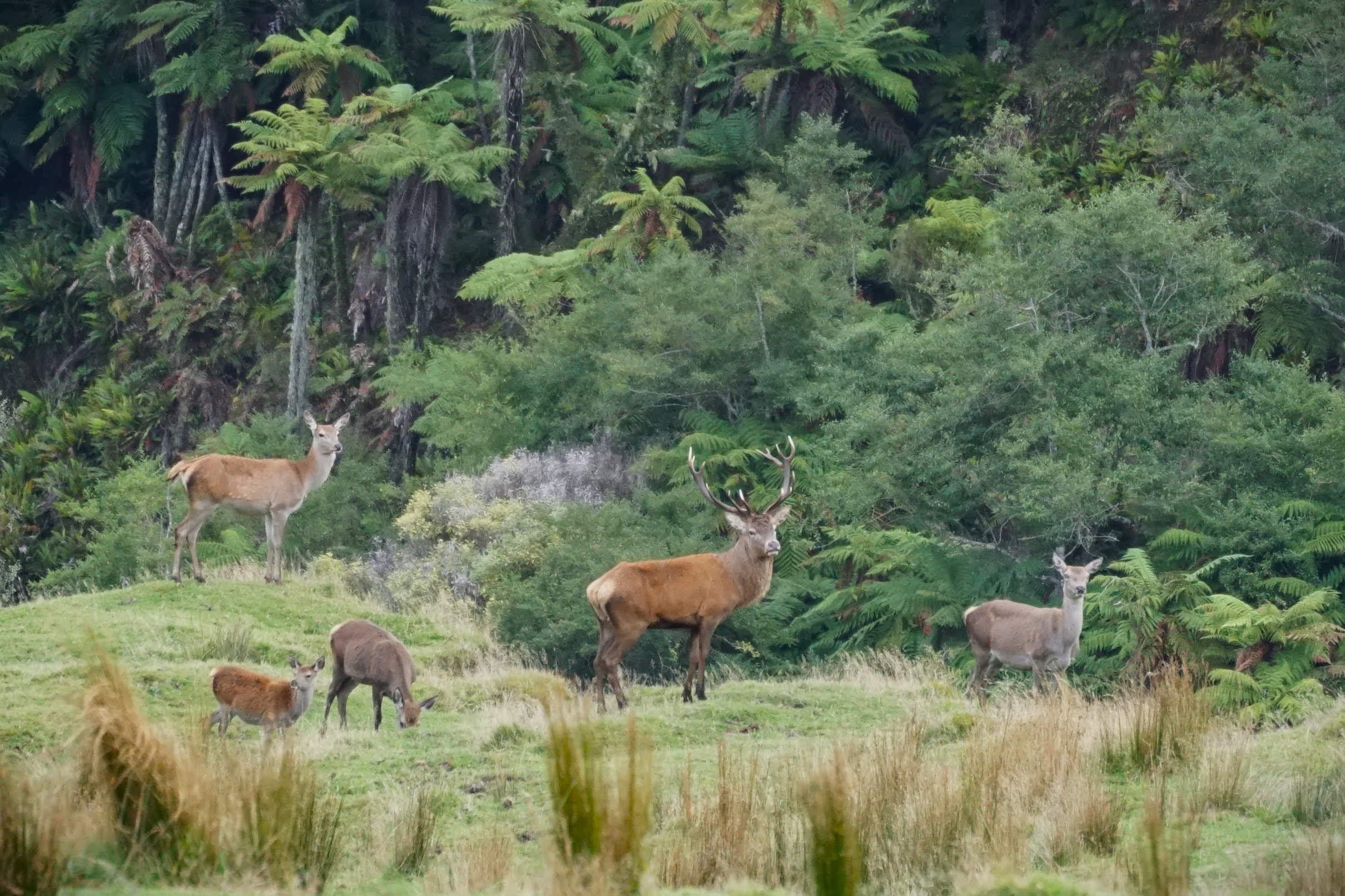Feral ungulates (primarily deer, goats and pigs) are more abundant in Aotearoa today than they have been for many decades, or in some areas, ever. Ask a hill country farmer or anyone who goes into the backcountry and they will tell you that the anecdotal evidence is clear in terms of devastated forest understories and high numbers of animals seen on farmland. And the science backs this up – numbers of ungulates have been climbing steadily for the last couple of decades across both public and private land.
Feral animals are having major impacts on biodiversity across old-growth and regenerating forests, in restoration plantings, on farmland (where they also eat pasture and crops) and in people’s backyards. They are also a major cause of erosion and floods, because they deplete the understorey and ground vegetation in native forests, releasing sediment and speeding up water loss. Feral ungulates are also vectors of diseases like Bovine Tb and predate on farm animals, especially pigs eating lambs.
Perhaps ironically, high feral animal densities also impact the quality of the animals that hunters seek to target. High densities lead to poor animal health and smaller animals.
”Feral animals have major impacts on biodiversity.
There are multiple complex reasons why ungulates are so abundant in Aotearoa today. Changes in Government funding of feral animal control, and especially defunding of the Department of Conservation is clearly one factor. But reduced helicopter hunting, because of the Covid lockdowns, changing public perceptions of hunting as a sport, and the massive increase in monocultures of exotic trees across rural Aotearoa are also important. Finally, the simple mathematics of population expansion plays a key role. Populations of feral ungulates all increase at an exponential rate if left unchecked, and we are now getting into the phase of extremely rapid expansion.
Recloaking Papatūānuku is an ambitious initiative to restore 2 million ha of native forests and wetlands within the next 10-30 years, with the aim to increase landscape resilience, help conserve our unique native biodiversity, and permanently sequester atmospheric CO2. Ungulates are a serious threat to the success of this programme, and therefore our ability to tackle the effects of climate change and address the biodiversity crisis in Aotearoa.
”Ungulates are a serious threat to tackling the effects of climate change and addressing the biodiversity crisis in Aotearoa.

Deer-browsed silver beech forest in Fiordland. Photo: David Norton.
The answer to this problem is to seriously reduce ungulate numbers through whatever tools are appropriate for an individual location (e.g. shooting, poisons, fences, etc). However, ungulate management is challenging because of ungulates’ large ranges, multiple land tenures are involved.
While it is easy to fence livestock like cattle and sheep out of areas being managed for Recloaking Papatūānuku, it is much harder to manage free-ranging feral ungulates using fences as they more easily go through or under fences than domestic livestock, and fencing is expensive and difficult to maintain in steep, rugged country. We also lack poisons for the effective control of these animals, so hunting is still the most effective control method at the scales required.
Ungulates also have a very high social value, which creates a significant tension in their management. To some Māori, pigs are seen as a Taonga, and many rural communities in Aotearoa are dependent on feral meat for protein. Feral ungulates are also a valued recreational resource and a small but important part of our tourism sector.
”Management of ungulates needs to reflect that these animals can have a very high social value.
But perhaps within this social dilemma also lies a solution to feral ungulate management, especially in the context of Recloaking Papatūānuku. The successful implementation of Recloaking Papatūānuku will need to be at the catchment scale, which is also the scale at which feral ungulate control needs to occur. Controlling deer or goats or pigs at the scale of an individual farm or restoration site will not work, as animals will keep reinvading from the wider landscape.
Catchment groups and Māori Incorporations/iwi groups will be instrumental in doing the mahi for Recloaking Papatūānuku on the ground. While it is clear that controlling deer (and goats and pigs) to low enough densities for new forests to be established or existing forests to recover is a task too large for recreational hunters alone, it is key that these communities are engaged in the process of managing ungulate numbers.
Initiatives such as the Eastern Whio Link project illustrate what we might do. This project, located in the Waioeka Catchment on SH2 between Opotiki and Gisborne, is hunter and fisher-led and aims to protect the Nationally Endangered whio (blue duck) across private farmland and public conservation land. By supporting these ‘hunter led’ groups with funding to engage cullers and helicopter shooters, we are best placed to achieve landscape-scale ungulate control that not only allows new forests to be planted, but also allows established forests to thrive.
The flow on benefits of working with such groups is that while much of the meat from an ungulate control operation is unable to be recovered, a portion of it can be redirected to fill community freezers. Plus, the offcuts can be utilised as bait to lure stoat and cat traps to in turn to further increase native biodiversity.
Recloaking Papatūānuku aims for an orders-of-magnitude increase in native forest and wetland restoration across Aotearoa. It needs to be implemented at a “tree-roots” level, working closely with local communities, which hunters are a part of. And if hunters are invested in the programme from the get-go, then we should be able to work together to obtain the best outcomes for everyone – hunters, our native forests, local communities and all of Aotearoa.
David Norton & Sam Gibson are contributors to the Recloaking Papatūānuku initiative, an urgent and ambitious programme to restore our indigenous forests, building on the Ō Tātou Ngahere partnership with Tāne’s Tree Trust. Find out more about the initiative here and sign up to join the movement.



Leave a comment